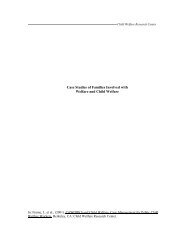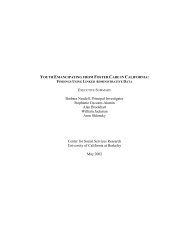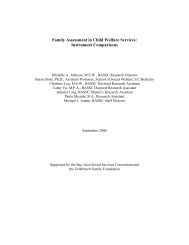Developing a Self-Assessment Toolfor Culturally - Office of Minority ...
Developing a Self-Assessment Toolfor Culturally - Office of Minority ...
Developing a Self-Assessment Toolfor Culturally - Office of Minority ...
Create successful ePaper yourself
Turn your PDF publications into a flip-book with our unique Google optimized e-Paper software.
Quality Monitoring and Improvement and Data Collection. To measure progress inproviding CLAS, health care organizations should periodically collect quality monitoringand improvement (QMI) data on community characteristics and needs (Cross et al. 1989;Washington State Department <strong>of</strong> Health 1998). Such QMI self-assessments shouldinclude the organization’s past and present performance in attempting to provide culturallyand linguistically appropriate services across several areas <strong>of</strong> care (Kim et al. 1992).Patient focus groups and patient satisfaction surveys are examples <strong>of</strong> methods used formonitoring CLAS quality (NPHHI 1998). Moreover, the routine collection and analysis <strong>of</strong>race and ethnicity data on the populations served is vital for effectively monitoring quality<strong>of</strong> care (Kim et al. 1992; NLBHW 1996; NPHHI 1998; Perot and Youdelman 2001; Smith1998).Staff Diversity. Another key component <strong>of</strong> culturally competent health care ishaving a racially, ethnically, culturally, and linguistically diverse staff (Washington StateDepartment <strong>of</strong> Health 1998). Such diversity should be reflected at various staff levels andfor various staff types. Although diversity is important regarding staff composition, it maybe even more important that staff reflect or represent the racial, ethnic, cultural, andlinguistic composition <strong>of</strong> the population served. (Kim et al. 1992). An additional staffingissue related to culturally competent care involves strategies for recruiting and retaining adiverse and culturally competent staff (NLBHW 1996; NPHHI 1998; Texas Department <strong>of</strong>Health 1998b).Staff Cultural Competence Training. In addition to recruitment, another strategy fordeveloping culturally competent staff is to provide them with training. Staff training incultural competence can serve “to enhance total system performance” (NLBHW 1996).Cultural competence training can be provided to staff on a continuous basis and mayaddress such topics as health care issues <strong>of</strong> specific ethnic groups, concepts <strong>of</strong> culture andCLAS, and ways to utilize community resources (Cultural and Linguistic Standards TaskForce 1997). Furthermore, policymakers can encourage or require staff training (for allstaff levels) in culturally appropriate service provision and can also set standards for thequality and content <strong>of</strong> such training (Cross et al. 1989; Washington State Department <strong>of</strong>Health 1998).Linguistic Support Services. Communicating with patients in their own languagehas been shown to improve: patient compliance and understanding <strong>of</strong> their disease(Manson 1988); patient self-reported well-being and functioning (Perez-Stable et al.1997); and access to primary care and preventive services (Jacobs et al. 2001). Studiesindicate that patients whose main spoken language is not English are less likely to receivetimely eye, dental, and physical examinations (Kirkman-Liff and Mondragon 1991). Also,patients with LEP have been shown to have fewer physician visits (Pitkin Derose andBaker 2000); and are less likely to return for follow-up visits after being seen in theemergency room, when compared to patients with English pr<strong>of</strong>iciency (Todd et al. 1993).COSMOS Corporation, December 2003 2-9
















